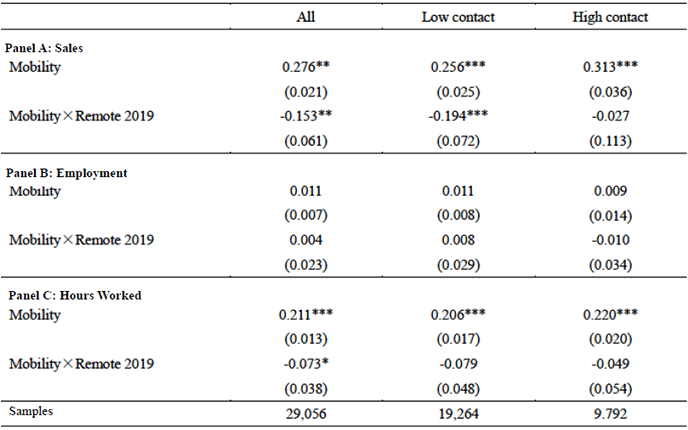| Author Name | KAWAGUCHI Daiji (Faculty Fellow, RIETI) / KITAO Sagiri (Senior Fellow, RIETI) / NOSE Manabu (International Monetary Fund / University of Tokyo) |
|---|---|
| Download / Links |
This Non Technical Summary does not constitute part of the above-captioned Discussion Paper but has been prepared for the purpose of providing a bold outline of the paper, based on findings from the analysis for the paper and focusing primarily on their implications for policy. For details of the analysis, read the captioned Discussion Paper. Views expressed in this Non Technical Summary are solely those of the individual author(s), and do not necessarily represent the views of the Research Institute of Economy, Trade and Industry (RIETI).
What effect did the dramatic decline in mobility due to the COVID-19 pandemic have on the performance of firms? In our research, we draw on a survey of Japanese firms during the COVID-19 pandemic to examine how changes in mobility due to the crisis affected firms' sales, employment and hours worked per employee, and how the implementation of Work-from-Home (WfH) arrangements helped firms to mitigate negative effects.
Lower mobility resulting from the Japanese government's declaration of a state of emergency and fear of infection led to a significant decline in the business activities of firms. As shown in Figure 1, the impact on performance was greater among firms that faced larger changes in mobility. We analyze this impact using mobility changes observed in the Google community mobility report and a survey of Japanese firms conducted by the Center for Research and Education in Program Evaluation (CREPE) at The University of Tokyo and Tokyo Shoko Research, Ltd. (TSR). We find that sales declined by an average of 2.8% and work hours by an average of 2.1% in response to a 10% drop in people's mobility, but we observe no effect on employment. This muted employment response is consistent with limited changes in aggregate employment at the extensive margin during COVID-19 in Japan. Analyzing this impact across different firm sizes and sectors, we find that the impact on sales and work hours was greater among smaller firms and those in higher-contact sectors such as retail trade and accommodation.

[Click to enlarge]
Did WfH arrangements help to mitigate the impact of this decline in mobility on firms' activities? We find that the impact on activities was effectively reduced among those firms that had adopted WfH arrangements by December 2019, prior to the advent of COVID-19. This result is shown in Table 1. As with the impact due to changes in mobility, we observe no effect on employment. However, we find that the adoption of WfH before COVID-19 mitigated the negative impact of the decline in mobility by approximately 55% in terms of sales and by approximately 35% in terms of hours worked. Moreover, we show that adapting to the crisis environment by increasing the number of employees working from home also helped mitigate the negative impact on sales and work hours. However, we also find that the mitigation effect of WfH arrangements differed substantially across firms and was limited to those in low-contact sectors, with no effect observed in high-contact sectors.
Note: Standard deviations are reported in parentheses. * p<0.1, ** p<0.05, *** p<0.01

The COVID-19 pandemic caused a sudden and massive disruption in firms' sales and work hours due to a substantial decline in mobility. In the context of the economic crises resulting from epidemics such as COVID-19, we find that greater diversification in labor input through WfH arrangements provides insurance device against unexpected shocks. At the same time, however, mobility change does not affect the performance of all firms in the same way, indicating heterogeneity in the mitigation effect due to WfH arrangements.
- Footnote(s)
-
- ^ The figure shows the average year-on-year changes in sales, employment and work hours for 20 groups of firms, classified by the change in mobility for each firm.

